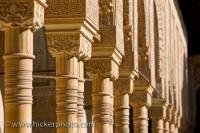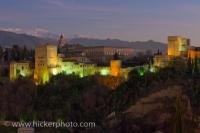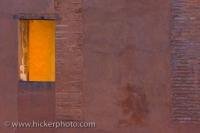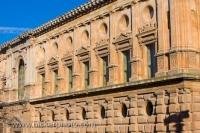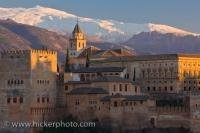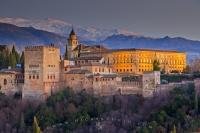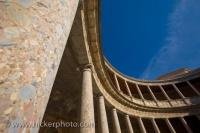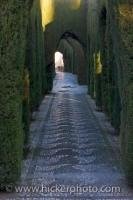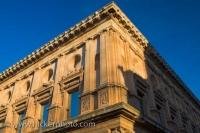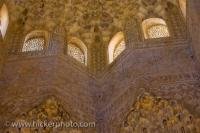Alhambra Pictures
Photo gallery of Alhambra pictures and photos, the world famous Alhambra (La Alhambra) is located in the city of Granada in Andalusia, southern Spain, photographed by Rolf Hicker. (There are 21 photos in this photo gallery.)
Before entering the grandeur and elegance of the Alhambra, in Granada, Spain in Andalusia, with its exquisite Moorish architecture, it is a good idea to visit the fortress Alcazaba, on the western side of the Alhambra. Ironically, not only was this 9th century stronghold a symbol of the start of the Moorish occupation of Spain, but the flag raised on the 25 metre Torre de la Vela, January 2nd, 1492 signified the end, when Ferdinand and Isabella banished the Islamic people from Granada.
The Alcazaba suffered damage over the centuries, and was rebuilt by different dynasties. In the 13th century Mohammed III used it as a private residence. Today, climbing the towers or walking along the ramparts should stir the imagination with visions of past battles, and the view, from Torre de la Vela, of the Granada countryside with the Sierra Nevada mountains in the distance is indescribable. ...More information below photos...
Interesting Photo galleries related to "Alhambra Pictures"
...Continue gallery information:
During the Moorish reign the Alcazaba and the Alhambra were separated by a ravine, but, after the Reconquista it was filled in to form the Plaza de los Albijes. In 1238, the Nasrid ruler, Ibn al-Ahmar, known also as Mohammed I, saw the potential of the fortress on the plateau, constructed more walls and towers and the Alhambra, (Arabic for 'red castle') was born. Ibn al-Ahmar, who had engineering talent, used the waters of the nearby Darro River, to provide running water for the new palace taking shape inside the walls.
The building of the Alhambra continued under the rule of Muhammed II, Yusef I and Mohammed V. The Salon de Embajadores, Hall of the Ambassadors, (1334 -1354) in the Torres de Comares, is the largest room in the Alhambra. The ceiling, made of cedar is designed with crowns, circles and stars. The white, gold and blue inlays depicts the seven Muslim heavens.
There are three Palaces of the Nasrid dynasty (Palacios Nazaries) - the Mexuar, where the state affairs, petitions and administration were carried out. The Golden Room has an lovely Renaissance ceiling. The Comares Palace (Cuarto o Palacio de Comares) was the residence of the reigning king, and the rooms, decorated with Koran inscriptions, leads to the Court of the Myrtles. The dense myrtle bushes line the long sides of the courtyard pool. The Baths (Banos) are also near the Comares Palace.
These Baths, similar to the Roman baths, are now decorated in the Christian fashion due to the necessary repairs and restorations since the 15th century. The Palace of the Lions (Palacio de los Leones) is Mohammed V's finest work, finishing what his father, Yusuf I had begun. The Palace of the Lions has a touch of Christian style as Mohammed was friendly with Pedro I (the Cruel One), a Christian king. This palace was both a residence and a ceremonial venue.
The rooms and halls lead to the most famous courtyard in the Alhambra - The Patio of the Lions. This courtyard is named for the twelve white marble lions depicting the twelve Zodiac signs, spraying jets of water from their mouths. Originally, each lion represented an hour and alternately spewed water every hour, however, somewhere back in time the 'clock' ceased to work. The twelve-sided basin atop the lions has a poem, by Zamrak, carved into the rim explaining the water system.
Although the Alhambra is opulent in design and architecture the Moors used simple materials in the construction such as wood, stucco and tiles. It was their fine craftsmanship which produced the beautiful results with repeated geometric designs (Arabesque) on walls, which symbolizes infinity, mosaics, stylized vegetal decoration, and the honeycomb design, Mocarabe, used on arches and columns. Water features are everywhere, fountains and pools reflecting the Moorish architecture to its full advantage.
After 1492, the Catholic Monarchy made alterations to some of the rooms of the Alhambra, but Charles V (Holy Roman Emperor) decided he wanted a palace, to show his 'Imperial power'. Built close to the Alhambra, Pedro Manchuca, a student of Michelangelo, was commissioned to build this residence. Considered to be the best example of Renaissance architecture, the construction began in 1527. The building is square - 63 metres each side. The circular courtyard inside is huge, with two levels of stone colonnades - suitable for bullfights. It is said Charles V never lived in the palace.
Compared to the elegant beauty of the Alhambra it is not easy to appreciate the Rennaissance style in this setting. In the 18th and 19th century the Alhambra fell into disrepair, and when Napoleon occupied Granada from 1808 to 1812 it was used as barracks for the troops. When they retreated Napoleon intended to blow up the Alhambra but fortunately only two towers were destroyed. In 1870 after years of neglect the Alhambra was declared a national monument, and today it is an UNESCO World Heritage Site.



